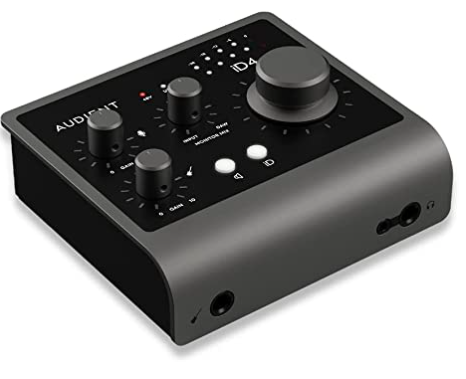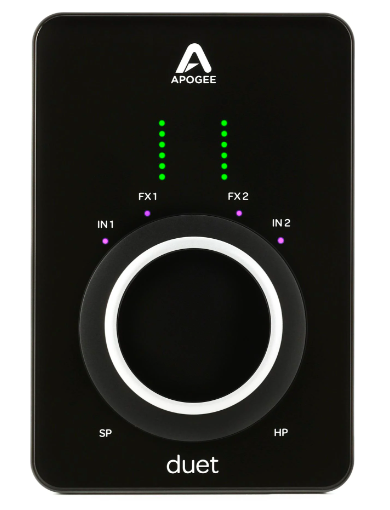When you buy through our links, we may earn an affiliate commission.
Entering the world of music production or podcasting requires certain gear that’ll define the audio quality of your project.
While it’s easier and more affordable than ever to record sounds professionally, especially on a Mac, understanding how to make the most of your tools will help you stand out and, who knows, turn your hobby into a full-time profession.
When it comes to sound recording, audio interfaces are one of those crucial pieces of equipment you need to take your music or podcast to the next level, helping you deliver audio at an industry-standard level.
Mac is renowned for being the best computer for creatives: it’s intuitive, versatile, and naturally compatible with most audio gear. So let’s take a look at the best choices for Mac available right now.
We'll cover all budgets: from under $100 up to 1K. Here you’ll find all the best options to upgrade your audio equipment depending on your financial availability.
However, you can also check out the best overall if you don't need one specifically for mac.
Let's dive in!
Quick Summary of Our Top Picks
- Focusrite Scarlett 2i2 (or 4i4) (Best for Beginners)
- Behringer U-Phoria UMC404HD (Best Versatile)
- Audient iD4 MKII (Best for Live-Streamers and Gamers)
- Universal Audio Apollo Twin (Best for Mac)
- M-Audio AIR 192 - (Best Under $200)
- Presonus Audiobox USB 96 (Best Under $100)
- Apogee Duet 3 (Best Portable)
Best Audio Interfaces for Mac
1. Best for Beginners – Focusrite Scarlett 2i2 (or 4i4)

SPECS
- Connectivity: USB
- Resolution: 24-bit/192kHz
- Input/Output: 2/2 (or 4/4)
- MIDI: NO
With tens of thousands of reviews online, the Focusrite Scarlett series has become one of the most beloved choices for Mac because of its affordability and exceptional sound quality.
There’s no doubt in my mind that the Scarlett series is the best option for solo artists or podcasters on a budget looking for a performing interface.
With two efficient mic preamps, the popular Air Mode, 48v phantom power for condenser microphones, and the direct monitoring option for zero-latency mixing and recording, you’ll get everything you need to get started and then some.
Another reason you should buy a Focusrite Scarlett is for the software bundle it comes with, including Ableton Live Lite, Splice, AutoTune, Landr Studio, and much more. If you’re a songwriter or producer working mostly at home, this is the one for you.
2. Best Versatile – Behringer U-Phoria UMC404HD

SPECS
- Connectivity: USB
- Resolution: 24-Bit/192kHz
- Input/Output: 4/4
- MIDI: YES
I’ve used the UMC404HD for a couple of years now and couldn’t be more satisfied. It’s a sturdy, versatile interface that’ll satisfy the needs of content creators who need multiple inputs, zero-latency monitoring and recording, and MIDI connectivity.
What makes this option truly stand out are the Midas preamplifiers, which give a natural feel to all recordings and also come with a +48V phantom power, giving you endless possibilities to customize your sound.
Not only podcasters and music producers but also DJs will find in the Behringer U-Phoria UMC404HD a priceless ally, thanks to its monitor A/B source option to cue tracks.
I've used the Behringer U-Phoria UMC404HD for music, podcasting, and DJ sets, and it never let me down, so I'd recommend it to those versatile artists looking for a trustworthy companion in content creation.
Enhance your audio journey with Behringer U-Phoria UMC202HD! Don't miss out on professional-grade sound.
3. Best for Live-Streamers and Gamers – Audient iD4 MKII

SPECS
- Connectivity: USB
- Resolution: 24-bit/96kHz
- Input/Output: 2/2
- MIDI: NO
Here’s an excellent and affordable option for creatives of all kinds - the Audient iD4 MKII is highly compatible with all Apple. It comes with professional preamplifiers and world-class DAC and ADC conversion to bring the best possible audio recordings to life.
Its compact size makes it ideal for those who are mobile.
Two headphone outputs, an impressive 120dB of dynamic range, and the intuitive Scroll Control software to handle your DAW directly from the interface are only some of the exceptional features of this powerful tool.
Finally, the audio loop-back mixer will allow you to customize your live-streaming content during your stream: perfect if you’re a gamer, recording videos or combining audio content on the go.
4. Best for Mac – Universal Audio Apollo Twin

SPECS
- Connectivity: Thunderbolt
- Resolution: 24-bit/192kHz
- Input/Output: 10/6
- MIDI: NO
In my opinion, this is easily the #1 choice for Mac. This is a superb option that can pretty much satisfy the needs of every recording artist or even professional recording studio.
It is professional grade and comes with an elite-class DUO Core processor, Dual Unison preamps, and the iconic Heritage software bundle that’ll undoubtedly upgrade your workflow.
The result is impeccable audio resolution, combined with near-zero latency and real-time processing for professional recording and mixing.
Finally, the Thunderbolt connection ensures the fastest possible audio conversion, comparable only to PCIe, with a latency of less than 2ms, even with large projects. This is for those who are serious about their artistry and want to take it to the next level.
For decades, Universal Audio has provided the world of music with ground-breaking hardware and software, so if you're looking for an excellent universal audio interface that'll last a lifetime, look no further than the Apollo Twin X.
5. Best Under $200 – M-Audio AIR 192

SPECS
- Connectivity: USB
- Resolution: 24-bit/192kHz
- Input/Output: 2/2
- MIDI: YES
The AIR 192 is a user-friendly USB interface packed with everything you need to record pristine audio.
Starting with the renowned low-noise Crystal preamps with phantom power to drive condenser microphones, M-Audio crafted a USB audio interface that allows recording analog and virtual instruments professionally and easily.
The mini MIDI in/out channels will help you make the most of your sound library and DAW, with high-quality controls highly compatible with most workstations.
In terms of bundles, the M-Audio AIR 192 comes with Ableton Live Lite and 2GB of Touch Loops, more than enough to get you started on your music production journey.
6. Best Under $100 – Presonus Audiobox USB 96

SPECS
- Connectivity: USB
- Resolution: 24-bit/96kHz
- Input/Output: 2/2
- MIDI: YES
I’m a big fan of Presonus because everything they do, from the exceptional DAW Studio One to the versatile Eris Studio monitors, is affordable but professional enough to take your sound quality to the next level.
The Audiobox USB 96 is no exception: for less than $100, you get a USB option that delivers pristine audio quality and an impressive array of plugins to expand your sound.
The high-quality preamps and the high digital resolution are some of the main features of this portable unit, but what really stands out here is the bundle you get when buying the Audiobox USB 96:
- Studio One Artist DAW
- Studio Magic
- Lexicon MPX-i Reverb
- SPL's Attacker Plus
This is a set of tools that’ll do wonders in the hands of both beginner and expert music producers, so for artists on a budget, the Audiobox USB 96 is by far one of the best options.
7. Best Portable – Apogee Duet 3

SPECS
- Connectivity: USB
- Resolution: 24-bit/192kHz
- Input/Output: 2/4
- MIDI: NO
Extreme portability without sacrificing sound quality. The Apogee Duet 3 has evolved dramatically since its first version came out in 2007: the powerful Duet 3 now comes with an onboard DSP that guarantees zero latency and the Apogee’s ECS Channel Strip with carefully crafted EQ, compression, and saturation.
The mic preamps offer pristine recording quality thanks to the cutting-edge Advanced Stepped Gain Architecture developed by Apogee, ensuring high-quality bandwidth with minimum distortion in the 0–65dB gain range.
The Apogee Duet 3 might well be the perfect companion for the touring content creator or the artists who need to optimize space while delivering content of the highest possible quality.
How to Select the One For You: Buyer's Guide
The market of audio interfaces for Mac offers a plethora of valid options for all budgets, so it might be difficult to choose one based exclusively on how much you can invest.
There are certain characteristics that all modern options provide, such as near-zero latency or CD-standard audio recording quality, so how do you choose the right one?
Here are the most crucial aspects you should take into account when buying a new audio interface, and that will help you narrow down your list.
Number of Inputs/Outputs
Two inputs might be enough for a songwriter or a home producer but definitely won’t satisfy the needs of a band recording their rehearsals or concerts.
Recording analog instruments, such as a guitar, a piano, or drums, require multiple microphones recording at the same time, meaning you’ll need enough inputs on your audio interface to record those musical instruments professionally.
Multiple outputs are excellent for having both speakers and headphones connected to your audio interface, which is ideal when mixing and mastering music. You might find only one headphone output limiting in the long run, so choose wisely.
All in all, I'd suggest you opt for an interface that has enough inputs and outputs to satisfy your needs long term. If you're a home producer, a good choice with two inputs will suffice, but if you're planning something more sophisticated, consider buying one with more inputs.
Podcast, Music Production, or Else?
Generally, a podcaster has fewer requirements than a musician when it comes to audio interfaces: you’ll probably need two professional recording microphones at most, so I wouldn’t invest in an interface with multiple inputs.
You'd be better off prioritizing reliability that offers high-quality recording. If you’re often recording outdoors, it might be good to look into battery-powered option
The world of live broadcasting also requires certain effects that not all options we reviewed offer. If you're into live-streaming, my recommendation is to look for an option with audio-loop capabilities that come with effects that allow adjusting audio in real-time (like the Audient iD4 MKII, from the list above).
Compatibility
Compatibility with iOS is almost never an issue, as Mac’s operative system is so versatile that most audio interfaces are just plug-and-play. Still, it’s good practice to do some research online and see if the interface you intend to buy works seamlessly with your Mac, your DAW, and the rest of your gear.
In terms of connectivity, I'd recommend choosing either a USB or Thunderbolt interface, as it'll make your life easier and provide you with high-quality recordings.
However, if you own a FireWire and want to connect it to your Mac, you can always get an Apple Thunderbolt to FireWire adapter to make it work.
Portability
If you’re traveling extensively, recording outdoors, or simply moving your studio around a lot, you should definitely go for the most portable equipment. There are quite a few great options for artists and podcasters looking for portable options, but my favorite is the Apogee Duet 3 and the IK Multimedia iRig Pro Duo.
Battery-powered choices are valid in many situations, as they allow you to carry them around with you and record at all times. If this sounds like something you might need, consider buying the excellent IK Multimedia iRig Pro Duo I/O.
Phantom Power
Phantom power is crucial if you’re using condenser microphones, and while most audio interfaces provide it nowadays, I’d recommend you don’t take it for granted.
Some have it only for one of their channels, so if you’re using more than one condenser mic simultaneously, you should consider other options.
Bundles included
All audio interfaces come with a set of products you can use to start making music right away. Usually, the bundle includes a DAW (Lite version) and a series of plugins and effects to craft your audio.
If this is your first one, buying one that has exactly what you need to get the most out of your audio might save you hundreds of dollars, so make sure you go over the bundles to find the one that perfectly fits your needs.
My recommendation is to look for interfaces that come with Ableton Live Lite, Presonus Studio products, Autotune Products, and a wide array of effects such as reverb, delay, compression, and saturation.
Frequently Asked Questions (FAQs)
What is an audio interface?
An audio interface is a device that converts analog audio to digital, allowing your DAW to record and store sounds.
By connecting one to your computer, you can use it to record analog instruments, such as a piano or a guitar, and monitor the audio through monitors or headphones connected to the interface.
Why do you need an audio interface for your Mac?
If you make music using “real” instruments or use microphones to record your podcasts, you’ll need an audio interface to convert the analog signal to digital. An audio interface allows you to record sounds professionally and gives you plenty of customization options to expand your sonic palette.
However, audio interfaces can do much more than just connect your musical instruments to your Mac. They can control your DAW, enhance the quality of your recordings, and give you new tools and effects to expand your sound.
What are the important specifications to look for in an audio interface?
The most crucial factors to consider when buying an audio interface are latency, resolution, number of inputs and outputs, MIDI I/O, and connection type. Most interfaces connect to your Mac via USB or Thunderbolt but always double-check the interface's specs before buying.
A headphone output might be enough for the traveling content creator, but if you're building a recording studio, you'll find it limiting.
Most USB choices these days offer high-quality mic preamps, dual headphone outputs, USB connectivity, valuable bundled software, and phantom power to connect condenser mics.
How much should you spend on an audio interface for Mac?
If this is your first audio interface, I’d recommend not spending more than $200. After all, there are plenty of affordable interfaces that offer good-quality audio recordings.
On the other hand, if you want to scale up your career and are looking for audio gear that can revolutionize your workflow, get an interface like the Universal Audio Apollo Twin X, which will open up a world of endless possibilities to expand your sound.
Final Thoughts
One last piece of advice: There’s no point in buying an ultra-performing audio interface like the Universal Audio Apollo Twin when you don’t know how to use it properly.
Whichever audio interface for Mac you buy, make sure you make the most of its features and don't go for bells & whistles you don't need.
Lastly, get one that’ll satisfy your needs long term: upgrading your recording studio constantly requires a lot of research and setting up, which I’m sure you want to avoid.
Infuse your studio with the prowess of the best Macs for music production, offering essential features and superior processing power.
Good luck, and stay creative!
Photo Courtesy Amazon & Sweetwater
